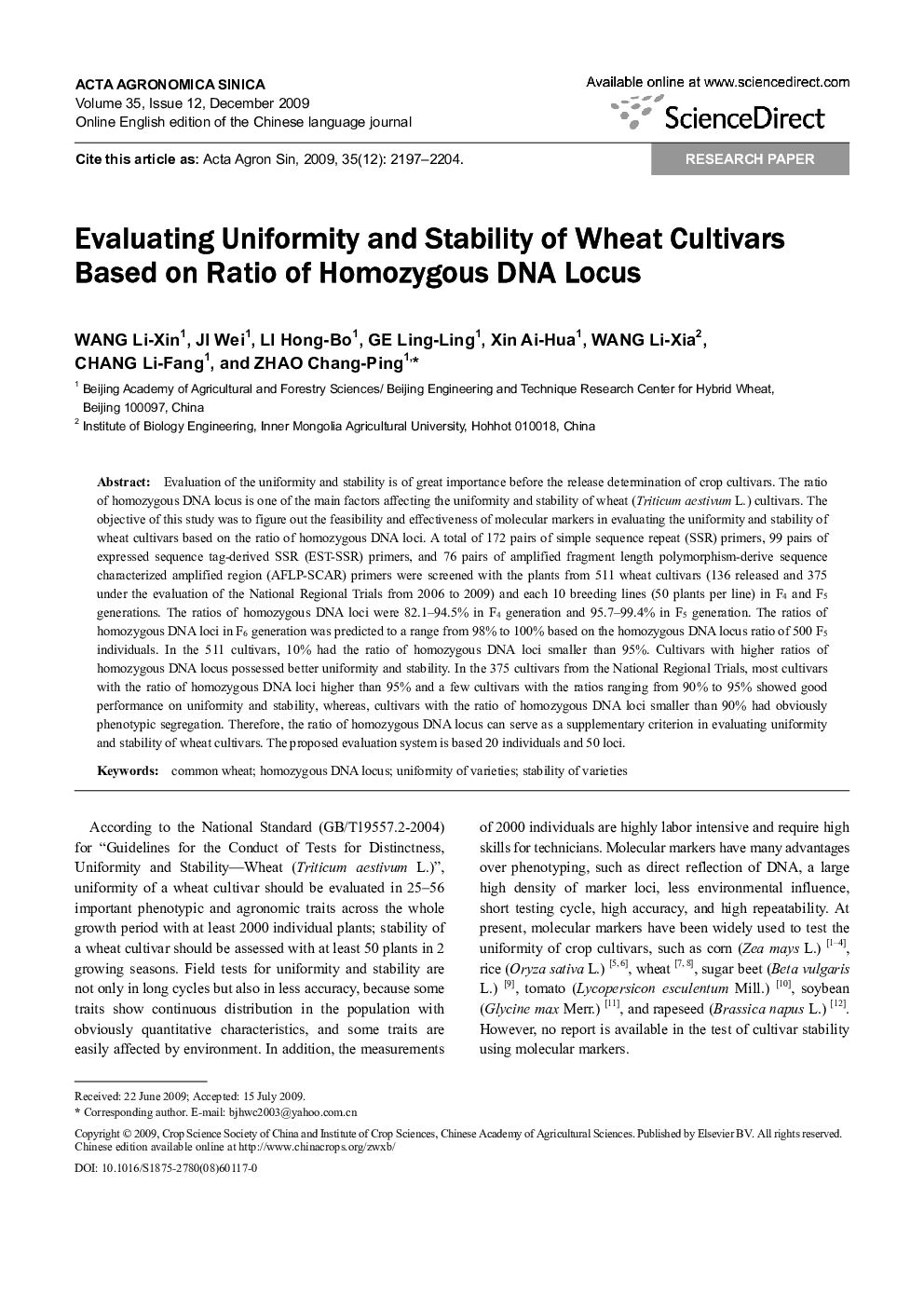| Article ID | Journal | Published Year | Pages | File Type |
|---|---|---|---|---|
| 4503283 | Acta Agronomica Sinica | 2009 | 8 Pages |
Evaluation of the uniformity and stability is of great importance before the release determination of crop cultivars. The ratio of homozygous DNA locus is one of the main factors affecting the uniformity and stability of wheat (Triticum aestivum L.) cultivars. The objective of this study was to figure out the feasibility and effectiveness of molecular markers in evaluating the uniformity and stability of wheat cultivars based on the ratio of homozygous DNA loci. A total of 172 pairs of simple sequence repeat (SSR) primers, 99 pairs of expressed sequence tag-derived SSR (EST-SSR) primers, and 76 pairs of amplified fragment length polymorphism-derive sequence characterized amplified region (AFLP-SCAR) primers were screened with the plants from 511 wheat cultivars (136 released and 375 under the evaluation of the National Regional Trials from 2006 to 2009) and each 10 breeding lines (50 plants per line) in F4 and F5 generations. The ratios of homozygous DNA loci were 82.1–94.5% in F4 generation and 95.7–99.4% in F5 generation. The ratios of homozygous DNA loci in F6 generation was predicted to a range from 98% to 100% based on the homozygous DNA locus ratio of 500 F5 individuals. In the 511 cultivars, 10% had the ratio of homozygous DNA loci smaller than 95%. Cultivars with higher ratios of homozygous DNA locus possessed better uniformity and stability. In the 375 cultivars from the National Regional Trials, most cultivars with the ratio of homozygous DNA loci higher than 95% and a few cultivars with the ratios ranging from 90% to 95% showed good performance on uniformity and stability, whereas, cultivars with the ratio of homozygous DNA loci smaller than 90% had obviously phenotypic segregation. Therefore, the ratio of homozygous DNA locus can serve as a supplementary criterion in evaluating uniformity and stability of wheat cultivars. The proposed evaluation system is based 20 individuals and 50 loci.
摘 要为了解小麦杂交组合高世代株系和我国小麦品种的DNA位点纯合率, 及其评价小麦品种一致性和稳定性的可行性, 采用172对SSR、99对EST-SSR和76对AFLP-SCAR引物, 检测了10个F4代株系、10个F5代株系和511个品种的DNA位点纯合率。结果表明, F4代和F5代株系的DNA位点纯合率分别为82.1%∼94.5%和95.7%∼99.4%。根据F5代500个单株的DNA纯合位点比率, 推测出F6代株系的DNA位点纯合率为98%∼100%。在511个品种中, 有10%的品种其DNA位点纯合率低于95%。通过比较证明, DNA位点纯合率越高品种的一致性和稳定性越好。对2006—2009连续3个年度国家冬小麦区域试验品种的检测证明, DNA位点纯合率高于95%的大多数品种和DNA位点纯合率为90%∼95%的少数品种具备一致性和稳定性; DNA位点纯合率低于90%的品种不具备一致性和稳定性。说明可以将DNA位点纯合率作为评价小麦品种一致性和稳定性的辅助标准。并提出了以20个个体为样本、检测50个DNA位点的小麦品种DNA位点纯合率检测方法以及检测方法中需注意的细节。
